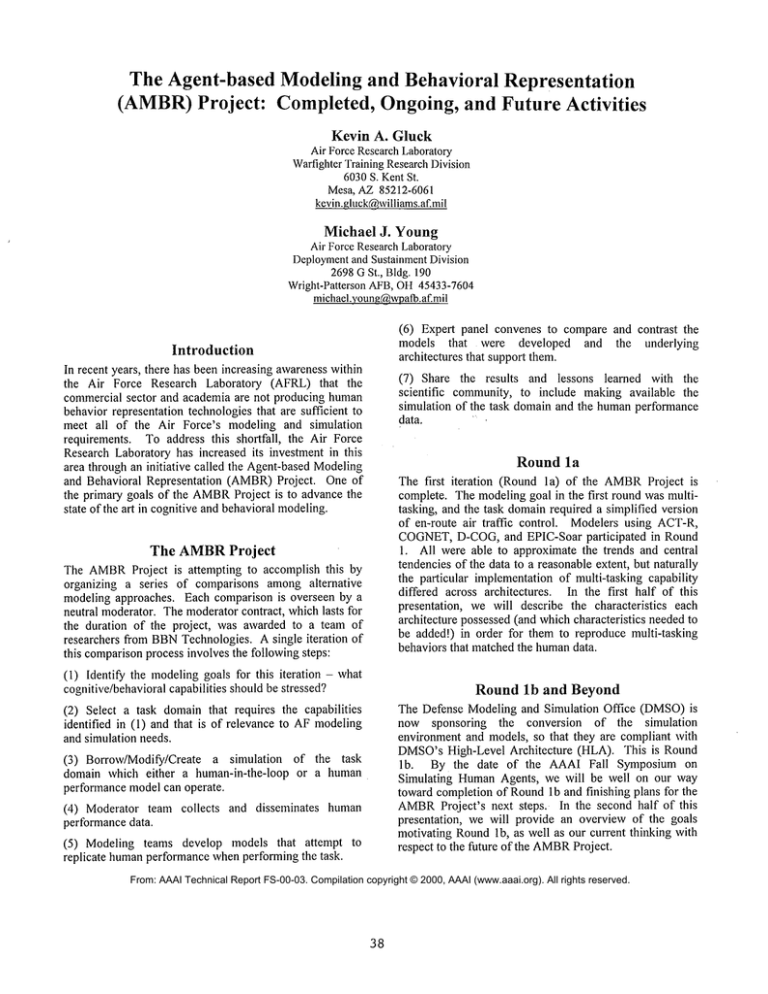
The Agent-based Modeling and Behavioral Representation
(AMBR)Project: Completed, Ongoing, and Future Activities
Kevin A. Gluck
Air ForceResearchLaboratory
WariighterTrainingResearchDivision
6030S. KentSt.
Mesa, AZ 85212-6061
kevin.gluck@williams.af.mil
Michael J. Young
Air Force ResearchLaboratory
Deployment
and SustainmentDivision
2698G St., Bldg.190
Wright-Patterson AFB,OH45433-7604
michael.voung@wpafb.af.mil
Introduction
In recent years, there has been increasing awarenesswithin
the Air Force Research Laboratory (AFRL) that the
commercial sector and academia are not producing human
behavior representation technologies that are sufficient to
meet all of the Air Force’s modeling and simulation
requirements. To address this shortfall, the Air Force
Research Laboratory has increased its investment in this
area through an initiative called the Agent-basedModeling
and Behavioral Representation (AMBR)Project. One
the primary goals of the AMBR
Project is to advance the
state of the art in cognitive and behavioralmodeling.
The AMBR Project
The AMBR
Project is attempting to accomplish this by
organizing a series of comparisons among alternative
modeling approaches. Each comparison is overseen by a
neutral moderator. The moderatorcontract, whichlasts for
the duration of the project, was awarded to a team of
researchers from BBNTechnologies. A single iteration of
this comparisonprocess involves the following steps:
(1) Identify the modelinggoals for this iteration - what
cognitive/behavioral capabilities should be stressed7
(3) Borrow/Modify/Create a simulation of the task
domain which either a human-in-the-loop or a human
performance model can operate.
and disseminates
(7) Share the results and lessons learned with the
scientific community, to include making available the
simulation of the task domainand the humanperformance
data.
Round la
The first iteration (Round la) of the AMBR
Project
complete. The modelinggoal in the first round was multitasking, and the task domainrequired a simplified version
of en-route air traffic control. Modelers using ACT-R,
COGNET,
D-COG,and EPIC-Soar participated in Round
1. All were able to approximate the trends and central
tendencies of the data to a reasonable extent, but naturally
the particular implementationof multi-tasking capability
differed across architectures. In the first half of this
presentation, we will describe the characteristics each
architecture possessed (and whichcharacteristics neededto
be added!) in order for them to reproduce multi-tasking
behaviors that matchedthe humandata.
Round lb and Beyond
The Defense Modeling and Simulation Office (DMSO)
now sponsoring the conversion of the simulation
environment and models, so that they are compliant with
DMSO’sHigh-Level Architecture (HLA). This is Round
lb. By the date of the AAAI Fall Symposium on
Simulating HumanAgents, we will be well on our way
toward completion of Roundlb and finishing plans for the
AMBR
Project’s next steps. In the second half of this
presentation, we will provide an overview of the goals
motivating Roundlb, as well as our current thinking with
respect to the future of the AMBR
Project.
(2) Select a task domainthat requires the capabilities
identified in (1) and that is of relevance to AFmodeling
and simulation needs.
(4) Moderator team collects
performancedata.
(6) Expert panel convenes to compare and contrast the
models that were developed and the underlying
architectures that support them.
human
(5) Modeling teams develop models that attempt
replicate humanperformance whenperforming the task.
From: AAAI Technical Report FS-00-03. Compilation copyright © 2000, AAAI (www.aaai.org). All rights reserved.
38





